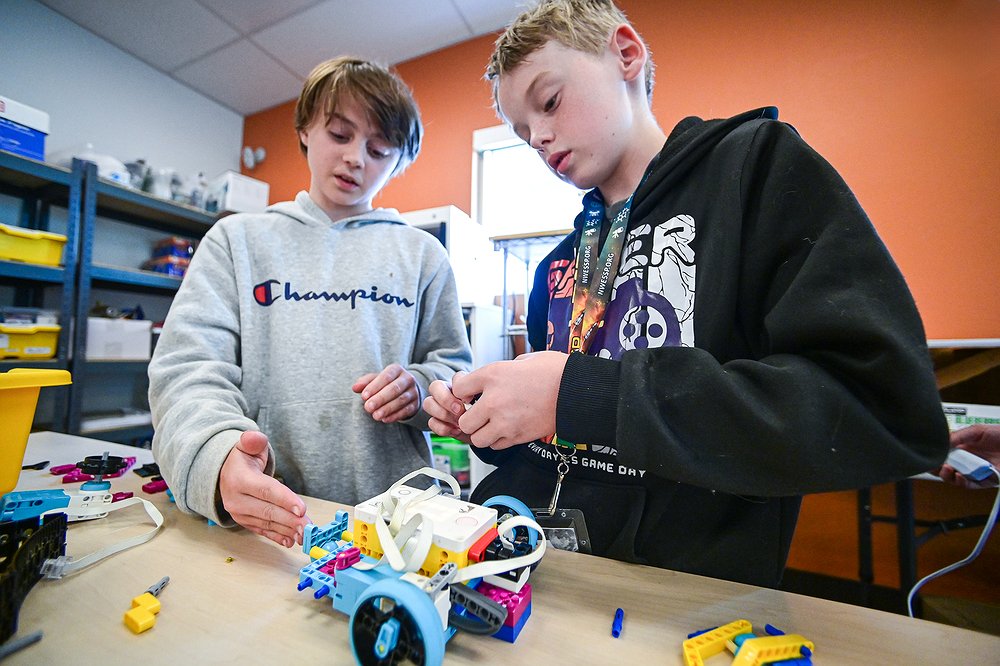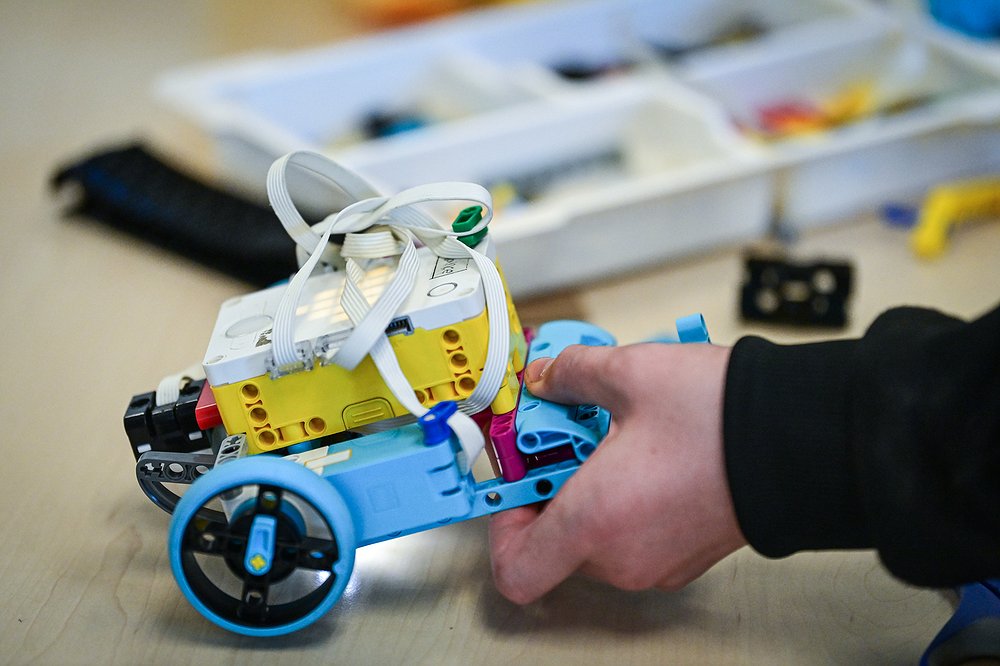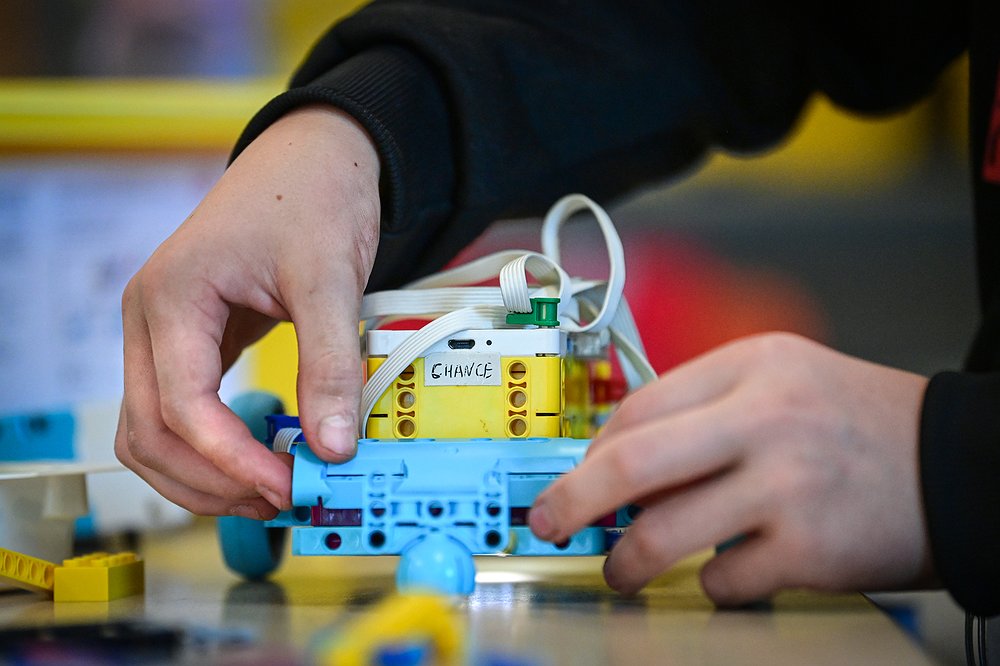West Valley campers explore the lunar landscape
Some West Valley students explored what it would take to turn the moon into a future home for astronauts through a mini-mission camp modeled after NASA’s Artemis program.
West Valley School seventh-grade teacher Matt Honcoop said to think of the moon as the next International Space Station but creating more advanced systems to sustain life long-term.
“That’s NASA’s Artemis mission in a nutshell,” he said.
July 22 through 26, Honcoop and math teacher Laura Browning led the free camp inspired by the Artemis II mission for fifth- through eighth-graders. According to NASA, the Artemis program seeks to advance scientific discovery and technology under the extreme temperatures and radiation of space to better prepare for manned missions to Mars.
“Looking beyond, if we can get good at doing this on the moon, this could be done on Mars. So essentially, it’s a simulated environment for going to Mars,” Honcoop said.
The mini-mission camp is an abbreviated version of an extracurricular program that was held during the school year at West Valley called Artemis ROADS (Rover Observation and Discoveries in Space) through Northwest Earth and Space Sciences Pathways.
“There’s a bunch of modules and units you go through and you keep a log like they’re doing here,” said student camp volunteer instructor Lillie Groom, who participated in the program during the school year.
Groom, an aspiring astrophysicist who will be a freshman at Glacier High School next year, said Artemis ROADS is a great entry point into following NASA missions.
“It’s not a competition, but you go to a hub event, and you meet other people and go through all these different activities like making a lunar base, building a rocket and doing rover stuff,” Groom said.
Northwest Earth and Space Sciences Pathways works to bring hands-on science activities inspired by NASA missions to the northwest and focuses on serving underserved or underrepresented communities in science, technology, engineering and math careers.
During the weeklong camp, participants learned more about the moon and “surveyed the lunar landscape” using robots, launching rockets and building closed-system terrariums and habitats with existing resources in addition to trying different recipes to make “lunar concrete.”
"Life in a lunar base or spacecraft is essentially a rocket-propelled terrarium where we recycle air, nutrients, water and energy to sustain life,” Honcoop said.
Honcoop said there is much to learn about the moon, which can further our understanding of how the solar system — and Earth — formed.
ON TUESDAY, students looked at high-resolution images of the moon’s surface using NASA’s JPL Moon Trek software, discussing and plotting a course for rovers capable of traversing the rim of a crater to the bottom — calculating the slopes of crater walls. Campers built and programmed their rovers to collect and deliver samples using Lego Spike Prime Education kits. Exploring craters requires calculations and finding a clear place to land a rocket and deploy rovers to investigate the crater bottoms before departing.
On Wednesday morning, students learned how different variables affect the dimensions of craters their rovers would explore. Using air-dry clay the students shaped “meteors” before heading outside where they filled foil trays with unsweetened cocoa powder and a layer of flour to simulate regolith. Some students couldn’t help but sample the cocoa powder, with Honcoop reminding them it’s not as tasty as it sounds. He used the moment as an opportunity to also explain what regolith is and how it’s different from Earth’s soil.
“Soil is made of organic materials because there’s bugs, and there’s microbes and there’s fungus, and all these roots and things. Soil’s a living thing, right? On the moon, we haven’t found any signs of life yet. So it’s devoid of life. That sand has never been touched by microbes, so it’s called regolith,” Honcoop said.
Groom said the groups were testing density, size, speed and angle of impact.
“We are testing speed,” camper Austin Hemmelman said.
“Other groups are testing size, weight and angles,” camper Brayden Hemmelman added.
Handing over a ruler, Honcoop reminded them to measure the width and depth of each crater. While most of the craters were flat at the bottom, one formed a small mound in the center. They shared their observation with Honcoop. He asked the group why that might be.
“So instead of it just blowing it out into the atmosphere you have a mountain rising up in the middle, which is again what you see,” he said, asking why that might be.
“Because it's not as much power,” camper Chance Rasmussen suggested.
“If it was just a low power impact you don't see that same kind of rise. You see a large crater wall. On a really high-speed impact, that rises back in the middle …,” Honcoop said.
Lunar craters may contain a treasure trove of information.
“The interesting thing about most of the craters, especially near the poles, is there's permanently dark regions that haven’t been exposed hundreds of thousands of years. So, there's water preserved in these areas, these older craters. So, NASA has a mission called VIPER, which is basically supposed to explore and research the bottom of these craters,” Honcoop said.
Unfortunately, the VIPER (Volatiles Investigating Polar Exploration Rover) was officially canceled last week due to budget shortfalls, but moon exploration will continue, according to a July 17 news release from NASA.
So why go back to the moon after the Apollo program?
“Certainly, we did touch down, grabbed some rocks, did some atmospheric samples and took off. Really that’s pretty much it. That was the Apollo program to get there and return,” Honcoop said. “The Artemis program is to basically get people on the surface of the moon who can stay there for up to 30 days and start a system where you can touch and go or you can revisit.”
Educational programs like Artemis ROADS serve to inspire the next generation of space explorers.
“I’m passionate about it,” Honcoop said. “I’ve been working with the Montana Aerospace Scholars Program, which has been run by the Montana Learning Center for quite some time. I’ve been a lead educator for that program for the past four years. That’s what kind of got me started in some of these missions.”
For more information on Artemis visit https://www.nasa.gov/specials/artemis. For more information on Northwest Earth and Space Sciences Pathways visit https://nwessp.org.
Reporter Hilary Matheson may be reached at 758-4431 or hmatheson@dailyinterlake.com.
 Luke Soteros, left, a seventh-grader, and Kason Browning, right, an eighth-grader strategize the construction and programming of their rover during a Northwest Earth and Space Sciences Pathways Artemis ROADS Mini Mission at West Valley School on Wednesday, July 24. (Casey Kreider/Daily Inter Lake)
Luke Soteros, left, a seventh-grader, and Kason Browning, right, an eighth-grader strategize the construction and programming of their rover during a Northwest Earth and Space Sciences Pathways Artemis ROADS Mini Mission at West Valley School on Wednesday, July 24. (Casey Kreider/Daily Inter Lake)Casey Kreider







